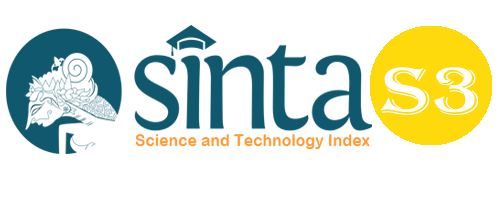The Effect of Quintuple Helix in Increasing Creativity and Innovation to Competitive Advantage the Creative Village in Bandung Municipality West Jawa Province
Abstract
The creative economy has contributed to economic development, but the development of the creative economy still has many problems, especially human resources, so that it has an impact on weak competitive advantage and performance. The purpose of this study was to examine the effect of the quintuple helix in increasing creativity and innovation and its impact on the competitive advantage of creative villages in the Bandung City Government, Java Bandung. The research method is mixed methods, namely quantitative and qualitative. The quantitative approach uses the statistical method of the Partial Least Square-Structural Equation Modeling (PLS-SEM) structural equation model, while the qualitative method uses descriptive and Soft System Methodology (SSM). For the quantitative approach, the sampling used Cluster Random Sampling with multi-stage cluster sampling and the data analysis used Partial Least Square- Structural Equation Modeling (PLS-SEM). The results showed that the quintuple helix (intellectuals, government, business, civil society, social ecology) had a significant effect on creativity and innovation. While the dimensions of the quintuple helix variables, namely intellectuals, government, civil society, social ecology have a significant effect on creativity, but business has no significant effect on creativity. Intellectuals, government, and civil society have a significant effect on innovation, but business and social ecology have no significant effect on innovation. Creativity has a significant effect on innovation. Creativity and innovation capability have a significant effect on the competitive advantage of creative villages. Meanwhile, for the descriptive approach and SSM produce a sextuple helix model which is a development of the quintuple helix model by adding a media helix and Information and Communication Technology (ICT) and in managing creative villages, metagovernance management is needed.
Keywords
Full Text:
PDFReferences
Abbas Tashakkori and Charles Teddlie. (1998). Mixed methodology. Combining Qualitative and Quantitative Approaches. Applied Social Research Methods Series Volume 46. Sage Publications: London.
Ade Saptono. (2010). Hukum dan Kearifan Lokal Revitalisasi Hukum Adat Nusantara. Jakarta: PT.Grasindo.
Amaral dkk. (2010). Micro-Evidence of a Triple Helix in The Brazilian Regional Development, Prosiding dari The Xxi ISPIM Conference 2010. Tanggal 6-9 Juni 2010, Bilbao, Spanyol.
Argent, N., Tonts, M., Jones, R., & Holmes, J. (2013). A creativity-led rural renaissance? Amenityled migration, the creative turn and the uneven development of rural Australia. Applied Geography, 44, 88-98. Retrieved from, http://espace.library.uq.edu.au/view/UQ:317859
Bagwell, S. (2008). Creative clusters and city growth. Creative Industries Journal, 1(1), 31-46. doi:10.1386/cij.1.1.31/1. Retrieved from, http://archive.londonmet.ac.uk/ www.citiesinstitute.org/library/b46466_3.pdf
Banner, G. (2002). Community Governance and the New Central-Local Relationship. International Social Science Journal, Vol. 54 No.172: 217- 231.
Bashor, C & Purnama, C. (2017). Factors Affecting Performance Manager and Its Impact on Competitive Advantage: Studies Small Medium Enterprises (SMEs) in the Shoes Industry Mojokerto East Java Province. Mediterranean Journal of Social Sciences. Vol 8 No 4 July 2017.
Bell, Stephen and Alex Park. (2006). the problematic metagovernance of networks: Water reform in New South Wales. Journal of Public Policy 26:0101.
Bogason, P. & Zolner, M. (2007). Methods for Network Governance Research: An Introduction in P. Bogason & M. Zolner (Eds) Methods in Democratic Network Governance (pp. 1-20). New York: Palgrave Macmillan.
Carayannis E. G. and Campbell D. F. J. (2010). Triple Helix, Quadruple Helix and Quintuple Helix and how do knowledge, innovation and the environment relate to each other? A proposed framework for a transdisciplinary analysis of sustainable development and social ecology, International Journal of Social Ecology and Sustainable Development 2010, 1(1):41– 69.
Cinzia. C and C. Porlezza. (2012). Innovation in Creative Industries: from the Quadruple Helix Model to the Systems Theory. Journal Knowledge Economy, (3), 343-353.
David. A. W & A. Bramwell. (2008). Innovation, creativity and governance: Social dynamics of economic performance in city-regions, Innovation: Management, Policy and Preactice, 10 (2), 2008.
European Commission. (2009). the World in 2025. Rising Asia and socio- ecological transition. European Commission, Brussels. Retrieved February 16, 2016, from https://ec.europa.eu/research/ social-sciences/ pdf/policy_reviews/the-world-in-2025-report_en.pdf.
Ezell,S., Spring,F. and Bitka,K. (2015). The Global Flourishing of National Innovation Foundations. https://itif.org/publications/2015/04/13/global- flourishing-national-innovation-foundations
Farazmand, Ali. (2004). Globalization and Governance: A Theoretical Analysis. In Farazmand, Ali. ed. 2014. Sound governance: policy and administrative innovations. USA: Praeger Publisher.
Sukarno, (2018). Memperkokoh Daya Saing Industri Kreatif Melalui Quintuple Helix, Kreatifitas Industri Dan Kapabilitas Industri. Seminar Nasional Manajemen dan Bisnis ke-3 Program Studi Manajemen Fakultas Ekonomi dan Bisnis Universitas Jember
Bougias and Anand Kulkarni. (2006). Rethinking Public Support of Science and Innovation in the National Interest: An Innovation Architecture Approach, submission to the Productivity Commission on the issue of Public Support for Science and Innovation in Australia.
Gerald. S. (2009). The Concept of Open Creativity: Collaborative Creative Problem Solving for Innovation Generation – a Systems Approach. Journal of Business and Management, 15(1), 5-33.
Gerston, L.N. (1992). Public Policy Making in a Democratic Society: A Guide to Civic Engagement. New York: M.E. Sharp Inc.
Hasan, B., & E., McVittie. (2009). Creative supply-chain linkages and innovation: Do the creative industries stimulate business innovation in the wider economy, Innovation: management, policy& practice, 11 (2), 169–189.
Hofstede, G. & Hofstede, G.J. (2005). Cultures and Organizations: Software of the Mind. New York: McGraw Hill
James. D., & Henry. E. (2008). Triple helix circulation: the heart of innovation and development. International Journal of Technology Management and Sustainable Development, 7 (2), 101-115.
Jessop, Bob. (2003). Governance and metagovernance: On reflexivity, requisite variety, and requisite irony. In: H. Bang (Ed.), Governance as Social and Political Communication. Manchester: Manchester University Press.
John W. Creswell. (1996). Research Design. Quantitative and Qualitative Approach. Sage Publication: London.
Jones, C., Hesterly, W. S., & Borgatti, S. P. (1997). A General Theory of Network Governance: Exchange Conditions and Social Mechanisms. Academy of Management Review 22(4): 911-945.
Kieser, A., & Leiner, L. (2012). Collaborate with practitioners: But beware of collaborative research. Journal of Management Inquiry, 21, 14-28. https://doi.org/10.1177/ 1056492611411923
Klijn, E-H. & Koppenjan, J. (2000). Public Management and Policy Networks: Foundations of a Network Approach to Governance. Public Management 2(2): 135- 158.
Larsen, P. & A. Lewis. (2007). Haw Award Winning SMEs The Barriers to Innovation. Journal Creativity and Innovation Management, 141-151.
Leydesdorff, L & Sun, Y. (2009). National and International Dimensions of the Triple Helix in Japan: University-Industry-Government versus International Co-Authorship Relations. https://arxiv.org/ftp/arxiv/papers/0911/0911.1055.pdf.
Leydesdorff, L & Fritsch, M. (2006). Measuring the knowledge base of regional innovation systems in Germany in terms of a Triple Helix dynamics. Research Policy (forthcoming). https://www.researchgate.net/publication/222836988
Maria, M., & J. P.A., Cuato. (2012). the triple helix model and dynamics of innovation: a case study. Journal of Knowledge-based Innovation, 4 (1), 36-54.
Meuleman, L. (2008). Public Management and the Metagovernance of Hierarchies, Network and Market. Berlin: Springer Berlin Heidelberg.
Mindarti. 2005. Menuju Good Governance. Cetakan Kesatu. Mandar Maju: Bandung.
Mustopadidjaja, A.R. (2002). Manajemen Proses Kebijakan Publik: Formulasi, Implementasi, dan Evaluasi Kinerja. Jakarta: Lembaga Administrasi Negara.
Parkman, I. D., Samuel S. H., & Helder. S., (2012). Creative industries: Aligning Entrepreneurial Orientation and Innovation Capacity. Journal of Research in Marketing and Entrepreneurship, 14(1), 95-114.
Parveen, S; Aslam Amat Senin; Arslan Umar (2015), Organization Culture an Open Innovation: A Quadruple Helix Open Innovation Model Approach, International Journal of Economics and Financial Issues, 5 (special issue): 335-342.
Rubalcaba, L., Michel, S., Sundbo, J., Brown, S. W., & Reynoso, J. (2012). Shaping, organizing, and rethinking service innovation: a multidimensional framework. Journal of Service Management, 23(5), 696-715.
Serger, S.S., Wise, E. and Arnold, E. (2015). National Research & Innovation Councils as an Instrument of Innovation Governance: Characteristics and Challenges. Vinnova Analysis VA 2015:07. Stockholm: Vinnova.
Skelcher, C., ET. al. (2011). Explaining the Democratic Anchorage of Governance Networks: Evidence from Four European Countries. Administrative Theory & Praxis 33(1): 7-38.
Skidmore, P., Bound, K. and Brough, H. L. (2006). Community Participation: Who Benefits? York: Josepph Rowntree Foundation.
The Department of Tourism, Regional Development and Industry, QueenslandGovernment Submission to the National Innovation Review, April 2008, p. 2.
Uyarra, E, and R, Ramlogan. (2016). the impact of cluster policy on innovation, in: Edler, J., Cunningham, P., Gök, A., Shapira, P. (Eds.), Handbook of Innovation Policy Impact. Edward Elgar, Cheltenham / Northampton, pp. 279-317. Lihat OECD (2011) Demand Side Innovation Policy, Paris: OECD.
Wahyono, W. (2002). “Orientasi Pasar dan Inovasi: Pengaruhnya Terhadap Kinerja Pemasaran (Studi Kasus Pada Industri Meubel di Kabupaten Jepara)”. Jurnal Sains Pemasaran Indonesia. 1 (1): 23-40.
Yannizar, et al. (2020). Analysis of Good Corporate Governance, Free Cash Flow, Leverage towards Earning Management, and Shareholder Wealth in Service Sector Companies Listed on the Indonesia Stock Exchange. Budapest International Research and Critics Institute-Journal (BIRCI-Journal).P. 2567j-2567v
DOI: https://doi.org/10.33258/birci.v5i1.3961
Article Metrics
Abstract view : 81 timesPDF - 45 times
Refbacks
- There are currently no refbacks.

This work is licensed under a Creative Commons Attribution-ShareAlike 4.0 International License.

This work is licensed under a Creative Commons Attribution-ShareAlike 4.0 International License.

_.gif)

















_.gif)



